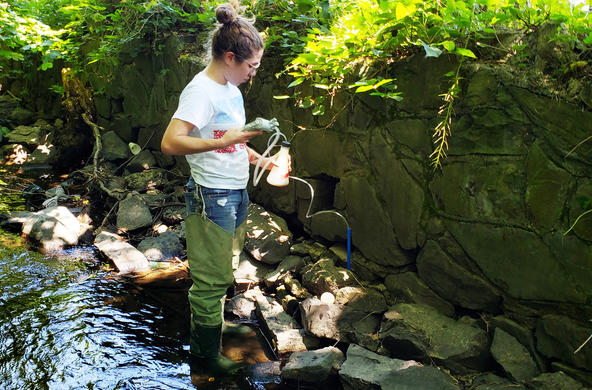This summer, I am studying eavesdropping behavior in birds on the Cary Institute campus – a property situated on 2,000 forested acres in upstate New York. Through this work, we are hoping to learn more about how birds use auditory information from different species, particularly alarm calls, to help them avoid predators.
To monitor birds, we first need to locate sites that birds visit. To do this, I set out bird food – seeds and mealworms – along wooded lowlands to attract birds. If we see that the food has been eaten, this lets us know that a bird has visited. We then set up video cameras at the site, in hopes that the bird will return so we can record its behavior while we play alarm calls.

We are mainly looking to attract ground foraging birds, such as robins and veeries, but we include other birds if they appear in our footage. The reason we are focusing on ground foragers is because they are more abundant in our study area and are more likely to forage in an open area that a video camera can record.
A typical day starts at about 4:30am. I wake up and drive to the sites where we have observed bird activity. I set up the cameras and let them record for about four hours. We monitor three sites at a time and if there is no activity, we move to other sites. After setting up the cameras, I wait for them to do their work. While I am waiting, I usually read, listen to podcasts, or just watch the birds in the trees. Over the course of this project, I have already seen a few birds for the first time in my life, such as the Indigo bunting and the American goldfinch.
When I finish video recording, I pack up and head back to Bacon Flats, the REU lodge, to analyze the footage and see if any birds visited the sites. If birds are recorded, then I can start my experiment.

First, we put out more bird food at the sites where birds were observed to lure them back. Then, using a speaker attached to an iPod shuffle, we play alarm calls of other birds at the sites and record birds’ behavior as they feed. From these recordings, I am monitoring two things: the total time that the focal bird spends in the camera’s frame and the number of times it turns its head to scan its surroundings.
Head turning and time spent at the site indicate the level of vigilance that the bird is exhibiting while feeding. A quick visit or lots of head turning tell us that the bird is less comfortable and more vigilant for predators. We think that birds will exhibit a change in vigilance behavior based on the species of alarm call we play. In other words, some birds’ calls might be perceived as being more reliable than others.
Currently, we are still waiting for more bird activity to explore this hypothesis. In the meantime, I am starting a backup project looking at the vocal repertoire of veeries. With this project, we are hoping to understand the different calls of veeries and how they use each call to communicate with each other.
This summer has been a valuable learning experience. Studying animal behavior requires patience and discipline. While I do not have a lot of footage of active birds, collecting the data that I have been able to capture has been exciting. Scrolling through hours of blank footage and then finally seeing a bird is quite satisfying. Hopefully I can collect sufficient data over the next few weeks to pursue my original research question, but if not, I have certainly tried my best and the overall experience has been a valuable one.
Camya Robinson, a student at the University of Florida, is part of Cary Institute's 2019 Research Experiences for Undergraduates (REU) program.
This summer, Camya is working with scientists Ken Schmidt and Chris Johnson, both from Texas Tech University, to study eavesdropping behavior in birds on the Cary Institute campus in Millbrook, NY.





